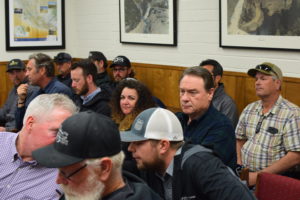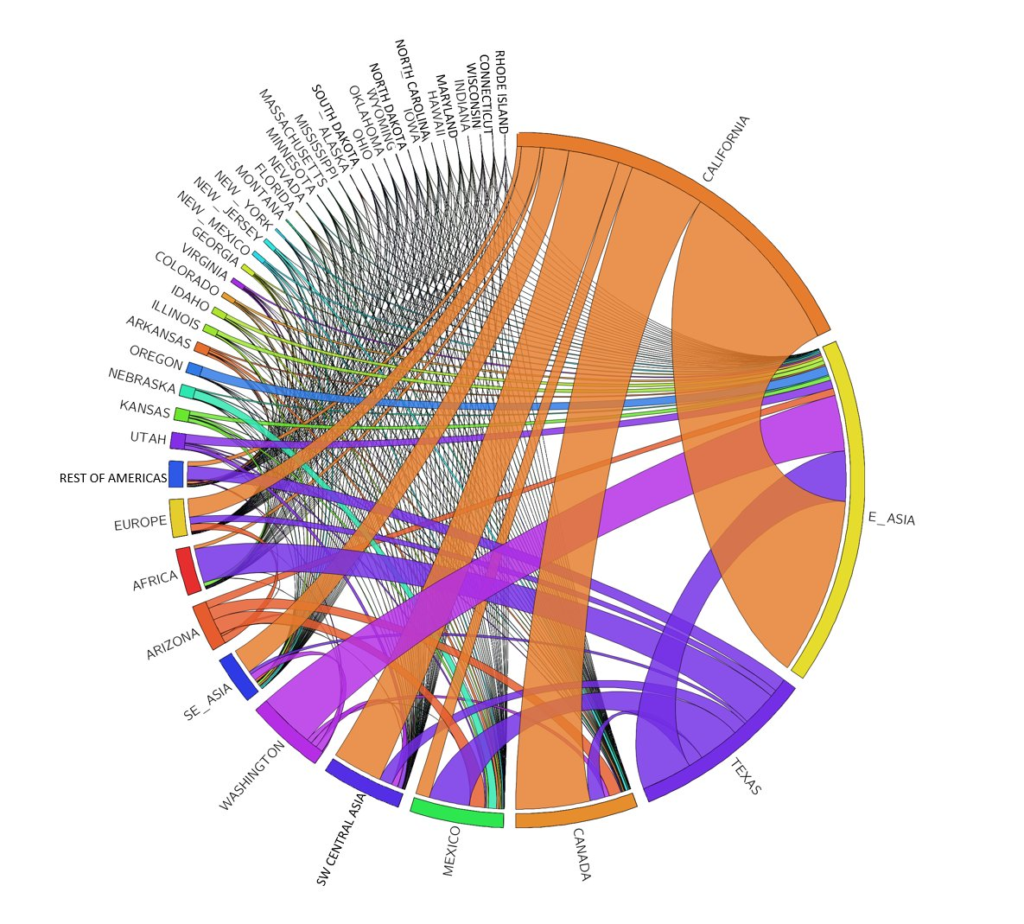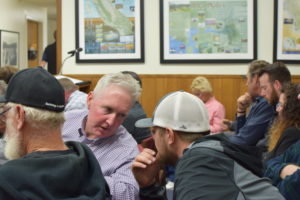Last July, the Oakdale Irrigation District (OID) Board of Directors agreed to develop a five year plan to deliver water to farmers outside district boundaries but within its sphere of influence.
Based on the board’s decision, several farmers who had petitioned for water began making good on their promises to provide infrastructure necessary for the deliveries. In some cases, hundreds of thousands of dollars were spent. Then, just last Tuesday, some OID board members appeared ready to renege on the agreement.
Given the gravity of the situation, the affected farmers were remarkably civil. Most had formed a coalition that not only worked together to provide infrastructure but also made sure the proposed deliveries were in compliance with the California Environmental Quality Act (CEQA).
Spokespersons for the farmers included Chase Hurley and Ronda Lucas. Hurley has extensive experience with water issues and use in the San Joaquin Valley, including a long term as General Manager of the San Luis Canal Company. Lucas is an attorney specializing in water law. She formerly represented the Modesto Irrigation District.

Anyone unfamiliar with OID’s long history of fabricating reasons to withhold water in order to justify water sales might have wondered why the board had suddenly grown hesitant to follow through on its plan to deliver water locally. The reason some members offered was that the board might not be able to deliver water every year for five years. That justification suffered a withering attack from board member Linda Santos, a firm supporter of keeping OID water local.
“Everybody in this room understands that this is only when we have water; nobody here thinks we can deliver water when we don’t have it,” said Santos more than once. “I would much rather see us keep our water here for us and our own basin.”
Santos’ concern for the groundwater basin in and around OID’s boundaries wasn’t just based on local concerns. Ever since implementation of California’s Sustainable Groundwater Management Act (SGMA) in 2014, water districts throughout the state have been required to produce plans for, “long-term sustainable groundwater management.”
Though OID has long relied on sales far south of the district to balance its books, it’s been forced to recognize that declining aquifers within and near its boundaries offer ample evidence that whatever plan it may or may not have, there’s no reason to believe it offers a sustainable alternative to depleted aquifers.
The clearest and simplest answer for OID, one that was emphasized by both Chase Hurley and Ronda Lucas, is to deliver OID surface water to farmers pumping the groundwater that is depleting the aquifer, especially since those same farmers are willing to absorb the costs for the infrastructure necessary to deliver the water.
In response to fears that the state might take some of OID’s water and use it for increased flows for fish, Lucas said the best way to protect its water rights is to tie them to beneficial uses within and near the district.
“I’d advise you to tie up every molecule of water you can,” she said. “I strongly urge you to go forward with this program as a win/win. You’re also protecting groundwater resources.”
Lucas is no doubt aware that the San Joaquin Valley is in government crosshairs as a result of overdrafting groundwater. In fact, California leads the world in agricultural income produced by unsustainable groundwater usage. Most of the pumping occurs in the San Joaquin Valley.

While board members Herman Doornenbal, Brad DeBoer, and Tom Orvis hemmed and hawed in obvious attempts to avoid committing to local deliveries, it was General Manager Steve Knell who made very clear the real reasons for OID’s reluctance to deliver water locally.
Knell reminded board members that OID has $7.5 million in annual expenses. He didn’t have to add the district’s farmers receive their water at far below the costs of delivery and it’s their unwillingness to pay those costs that forces OID to peddle water to buyers in regions farther south.
The prospect of not having water to sell far outside the district could mean district farmers might actually have to pay for their water, a thought positively abhorrent to businesses long accustomed to socializing costs and privatizing profits.
General Manager Knell also didn’t need to mention that some of the district’s recent costs have come in the form of lost lawsuits, first in a case about their failure to observe CEQA protocols associated with an attempted water sale, and then in a case where the district sued two of its own board members for what amounted to telling the truth to a judge. The two board members, Gail Altieri and Linda Santos, just happen to be the only board members in favor of keeping OID surface water local.
OID’s recent overhead has thus included not only the fees of its own attorneys in fruitless lawsuits but also the costs of reimbursing opposing attorneys’ fees because judges viewed OID’s positions in both cases as indefensible.

Judges aren’t the only authorities who’ve found OID’s excuses for selling water specious. The state water board responded to OID’s claim that loss of subsidies from water sales would result in fallowing and end conservation in OID’s service area by replying that OID, “provides no substantial evidence for either claim.” The board added remarks that would be an embarrassment if OID farmers and its three majority board members were capable of shame:
“Moreover, there are growers neighboring OID’s service area that are not subsidized by equivalent water sales but find it economically viable to continue producing crops, maintaining infrastructure, and investing in improvements.”
In an ironic challenge to what are most likely obsolete notions of integrity, Tom Orvis, Chairman of the OID Board of Directors, also sits on the Stanislaus County Water Advisory Committee. The committee’s mission statement would seem to offer a cogent argument in favor of using OID surface locally instead of depleting groundwater. The mission statement reads as follows:
To evaluate the status of the groundwater resources of Stanislaus County in order to identify and develop programs and practice that insure a reliable and sustainable groundwater supply for the benefit of its citizens, present and future, and to make recommendations to the county board of supervisors to adopt public policy that empowers such identified actions.
Orvis isn’t alone in holding a seemingly contradictory position on water sales. When the neighboring Modesto Irrigation District proposed selling what it then called “surplus water” to the City of San Francisco, the public outcry was uproarious and included local political leaders. On the other hand, OID sales to distant buyers have prompted little public comment and even less criticism from local leaders.
Apparently, no one in the region realizes the inherent contradiction in railing against so-called “water grabs” by the state and then retailing local “surplus” water. The water board’s warning to OID that, “The waters of California belong to the public and cannot be owned by any individual or entity,” in July of 2018 should have offered warning enough that continuing to sell water jeopardizes the district’s water rights, but three of OID’s board members seem less concerned about losing their rights than about meeting local farmers’ demands for subsidized water. Their willingness to gamble could in the end wound the entire region should the state decide that OID’s “surplus” water has better uses elsewhere.

good article on OID’s continued ‘good old boys’ process of selling water vs. keeping it local. Local water irrigation replenishes the ground water aquifer as well, as the large majority of the water used by farmers goes back into the ground. Maybe it is time for the southern area of this valley to look at increasing capacity in our reservoirs – an added 10 feet of capacity and better systems to capture the rain that falls from the sky (90% of the rain goes back to the ocean), or possibly a few De-Salination plants might help too. 97% of the water on this planet is in the oceans.
This is not the first time California growers have invested heavily in water delivery infrastructure only to have the rug pulled out from under them. The water from the CVP’s Trinity River Division was intended for growers on the west side of the Sacramento Valley, that still-parched patch from Williams south. The Congressman from that area, Clair Engle, chaired the House Committee on Interior and Insular Affairs – what could assure that water more than that? Instead, Engle helped redirect that water away from his own constituents and into the newly-formed Westlands Water District, a cruel betrayal of his own ranching families, many of whom had gone heavily into debt to construct the canals to receive that Trinity River water. Having ‘backed his karma over his dogma’ Engle died at age 52.
Great article Eric.
Many issues close to my heart about water subsidies and groundwater uses.
It is time for the OID to consider urban water treatment so the local water stakeholders, the City dwellers, can firm up the water rights that also belong to them.
Yes, it is also time that the ag users address the “cost of service” and the Board move to that goal of charging the actual cost for irrigation water delivery.
These same issues are problems for the Modesto Irrigation System.
Hopefully, the coming election can help choose proper leadership for the MID.
It is time to keep our local water resources local. Our groundwater sustainability is important. OID can balance its books and not sell water outside the basin.
It may also be time to take interest in OID finances and find out where thenrecenues from marketed water are going.
I agree Mr. Duarte!